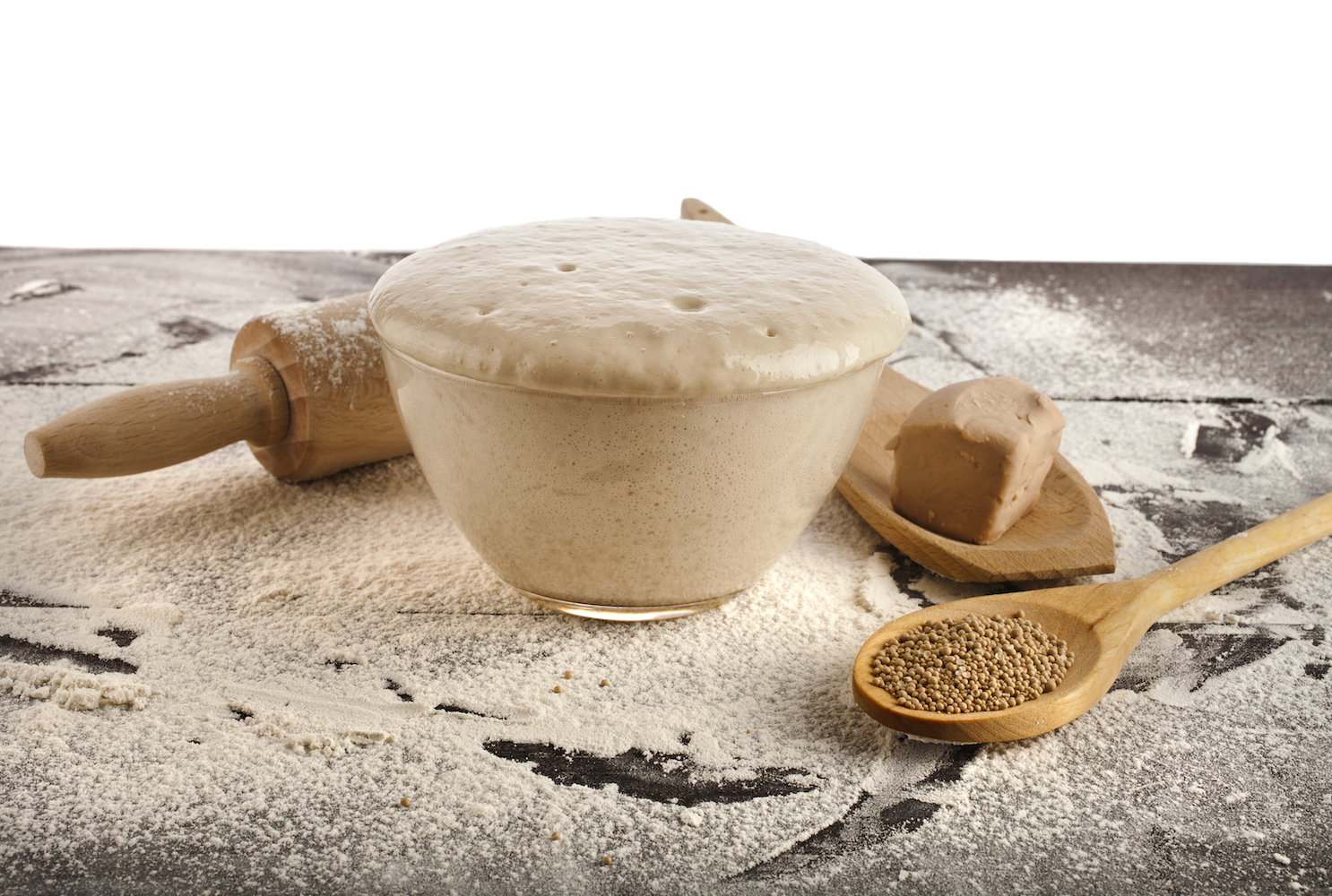
Adding a Sponge to Dough to Make Bread
A sponge or yeast starter is similar to sourdough, except a sponge is make from all fresh ingredients. A sponge is allowed to ferment and increase in volume before it is added to bread dough.
In the 1800s, cooks used wood burning stoves, which had no thermometers. So not only did they have to learn how to cook various foods, they also had to learn to gauge the oven’s heat temperature. Baking was definitely an important skill!
INFORMATION BELOW COMPILED FROM 1800s COOKBOOKS
Bread raised with what is known to bakers as a “sponge,” requires more time and a trifle more work than the simpler form. But it keeps fresh longer, is softer and more nutritious, and a second-rate brand of flour thus treated produces a better loaf than when mixed up with yeast and water only. Sponge-making is therefore, an important if not an essential accomplishment in a cook, be she novice or veteran.
BREAD BAKING ADVICE
Many people bake their bread slowly, leaving it in the oven a long time, and this causes a thick, hard crust.
When baked in the modern iron oven, quick baking is necessary. Let the oven be quite hot, then put a little ball of paste in and if it browns palely in seven to ten minutes, it is about right. If it burns, it is too hot. Open the damper ten minutes. Let your bread get light, but not too light—twice its bulk is a good rule.
But if it is light before your oven is ready and thus in danger of getting too porous, work it down with your hand. It will not harm it, although it is better to manage that the oven waits for the bread rather than the bread for the oven.
A small loaf—and by all means make them small until you have gained experience—will not take more than three quarters of an hour to bake. When a nice yellow brown, take it out, turn it out of the tin into a cloth, and tap the bottom. If it is crisp and smells cooked, the loaf is done. Once the bottom is brown it need remain no longer.
Should that, however, from fault of your oven, be not brown, but soft and white, you must put it back in the oven, the bottom upwards. An oven that does not bake at the bottom will be likely to spoil your bread. It is sometimes caused by leaving a collection of ashes underneath it. Satisfy yourself that all the flues are perfectly clean and clear before beginning to bake.
TO MAKE A BREAD SPONGE WITH POTATOES
- Three potatoes of fair size, peeled and boiled mealy.
- Five tablespoons of yeast.
- One tablespoon of white sugar.
- One tablespoon of butter.
- Three cups of lukewarm water in which the potatoes were boiled—strained through a coarse cloth.
- One heaping cup of sifted flour.
Put the potatoes into a large bowl or tray and mash them to powder with a wooden spoon. While still hot, mix in the sugar and butter, beating all to a lumpless cream.
Add the potato-water a few spoonfuls at a time, alternately with the flour by the handful. Beat the batter smooth as you go on until all of the liquid and flour has gone in. Beat hard one minute before pouring in the yeast. In hot weather, it is well to stir into the yeast a bit of soda no larger than a grain of corn already wet up in a teaspoon of boiling water.
Now whip up the batter with a potato beetle* or wooden spoon for another minute, and the sponge is made.
Throw a cloth over the bowl and set by for five or six hours to rise. If you intend to bake in the forenoon, make the sponge at bedtime. If in the afternoon, early in the morning.
*beetle – a wooden kitchen utensil about twelve inches long, used to mash food.
BREAD SPONGE (Plain)
- One quart warm water.
- 6 tablespoonfuls baker’s yeast.
- 2 tablespoonfuls lard.
- 2 tablespoonfuls white sugar.
- 1 teaspoonful soda.
- Flour to make a soft batter.
Melt the lard in the warm water, add the sugar, then the flour by degrees, stirring in smoothly. A quart and a pint of flour will usually be sufficient if the quality is good. Next comes the yeast, lastly the soda. Beat up hard for several minutes. Cover lightly if the weather is warm, move closely in winter, and set to rise overnight in a warm place.
RECIPE FOR FAMILY BREAD
2 quarts of flour.
2 tablespoons of lard or butter.
2 teaspoons of salt.
Enough sponge for a two-quart loaf of bread.
Mix with one pint of sweet milk.
Make into rolls and bake with very little fire under the oven.
NOTE: The recipe above is quite vague, but I included it because it accompanied the plain bread sponge recipe. This type of recipe is not unusual; many cookbook authors assumed you already knew how to bake bread, cakes, pies, and other baked goods, so they just gave the ingredients.
AUNT SARAH’S WHITE BREAD (SPONGE METHOD)
When preparing to set bread, place in a large bowl one pint of potato water, one tablespoon of sugar, one pint of the yeast sponge, one-half teaspoon of salt, and use about three pounds of sifted flour, well-dried and warmed.
Knead from 15 to 20 minutes until a stiff dough is formed. The dough should be fine-grained and elastic and not stick to the bake board. Place dough in the bowl to rise, which should take about four hours. When well-risen and light, knead down and set to rise again, about one and one-half hours. When light, mold into three large, shapely loaves. Place in pans and allow to stand one hour. When loaves have doubled in bulk, are very light and show signs of cracking, invert a pan over the top of the loaves, and place in a rather hot oven* to bake.
Brush melted butter over loaves of bread when set to rise, which will cause bread to have a crisp crust when baked. The old-fashioned way of testing the heat of an oven was to hold the hand in the oven, if possible, while one counted thirty.
When baking bread, the oven should be quite hot when bread is first placed therein, when the bread should rise about an inch. Then the heat of the oven should he lessened and in a half hour a brown crust should begin forming. During the latter part of the hour (the time required for baking an ordinary-sized loaf) the heat of the oven should be less, causing the bread to bake slowly.
Should the heat of the oven not be great enough when the loaves are placed within for baking, then poor bread would be the result. This method of making bread will insure most satisfactory results, although more troublesome than ordinary methods.
The pint of yeast remaining in the jar may be kept in a cool place one week, and may be used during this time in making fresh “yeast foam.” This should always be prepared the day before baking bread. Always prepare double the quantity of “yeast foam.” Use half to set bread, and reserve half for next baking. Bread baked from this recipe has frequently taken first prize at County Fairs and Farmers’ Picnics.
*hot/quick oven – about 400-450 degrees Fahrenheit.
Sponge Starter Recipe from the Food Network
=================================================
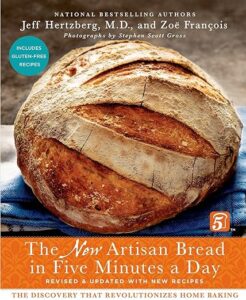 The New Artisan Bread in Five Minutes a Day: The Discovery That Revolutionizes Home Baking
The New Artisan Bread in Five Minutes a Day: The Discovery That Revolutionizes Home Baking
The New Artisan Bread in Five Minutes a Day is a fully revised and updated edition of the bestselling, ground-breaking, and revolutionary approach to bread-making–a perfect gift for foodies and bakers!
The link goes to a list of booksellers where you can buy this book online. Some of the booksellers also sell a printed version.
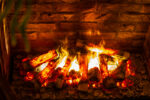
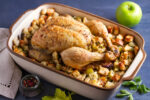
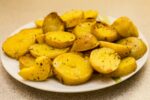
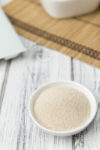
5 thoughts on “Adding a Sponge to Dough to Make Bread”
I just ordered a new “used” copy of the Ohio State Grange Cookbook, 10th edition, 1948. The one I had was given me by my grandmother. I lost it in a move. Actually, I lost all of my cookbooks and hand written, hand me down recipes at the same time and have sorely missed them ever since.
Sponge is referred to many times. Oh, and bread doesn’t rise, it get “light.” Just having the greatest time today going over old recipes.
Cheers!
How fun to reconnect with the book your grandmother gave you. I’m sure sorry to hear of you losing all your cookbooks and handwritten recipes, though. Maybe you can ask some of your older relatives or friends if they have cookbooks or recipes they could give you or loan to you.
Is this kind of like sourdough? I don’t eat bread much anymore but these recipes sound delicious.
It’s similar to sourdough, but has a shorter pre-fermentation. Here’s a good article about it.
https://www.washingtonpost.com/lifestyle/food/better-bread-starts-with-a-sponge/2013/02/04/86ad2460-69a4-11e2-af53-7b2b2a7510a8_story.html
I wasn’t familiar with this method. I think it’s a bit too slow for most of today’s cooks.